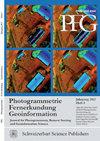基于AdaBoost的高光谱数据集成分类系统
Q Social Sciences
引用次数: 0
摘要
针对高光谱数据的高维问题,提出了一种基于AdaBoost的多分类器系统。高光谱数据首先根据相邻波段之间的相似性划分为多个波段簇,每个波段组被视为一个独立的数据源。然后使用分支绑定技术去除每个簇中的冗余条带。接下来,将支持向量机(SVM)应用于每个聚类,并使用AdaBoost迭代中计算的权重将输出组合起来。在AVIRIS和ROSIS数据集上的实验结果清楚地表明,与其他多类er系统相比,该算法在整体和单类精度方面都具有优势。对于包含更复杂的类和更少可用训练样本的AVIRIS数据,AdaBoost结果的总体准确性之间的差异明显高于其他方法,并且比其他数据集更明显。在类精度方面,所提出的AdaBoost方法在大多数类中也优于其他方法。本文章由计算机程序翻译,如有差异,请以英文原文为准。
An AdaBoost Ensemble Classifier System for Classifying Hyperspectral Data
This paper presents a new multiple
classifier system based on AdaBoost to overcome
the high dimensionality problem of hyperspectral
data. The hyperspectral data are )rst split into a
number of band clusters based on the similarities
between the contiguous bands, and each band
group is considered as an independent data source.
The redundant bands in each cluster are then removed
using branch and bound technique. Next, a
support vector machine (SVM) is applied to each
cluster and the outputs are combined using the
weights calculated in AdaBoost iterations. Experimental
results with AVIRIS and ROSIS datasets
clearly demonstrate the superiority of the proposed
algorithm in both overall and single class accuracies
when compared to other multiple classi)er systems.
For AVIRIS data, which contains classes
with greater complexity and fewer available training
samples, the differences between the overall
accuracies of the AdaBoost results are signi)cantly
higher compared to those of the other methods, and
more pronounced than for the other dataset. In
terms of class accuracies, the proposed AdaBoost
approach also outperforms other methods in most
of the classes.
求助全文
通过发布文献求助,成功后即可免费获取论文全文。
去求助
来源期刊

Photogrammetrie Fernerkundung Geoinformation
REMOTE SENSING-IMAGING SCIENCE & PHOTOGRAPHIC TECHNOLOGY
CiteScore
1.36
自引率
0.00%
发文量
0
审稿时长
>12 weeks
 求助内容:
求助内容: 应助结果提醒方式:
应助结果提醒方式:


